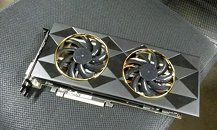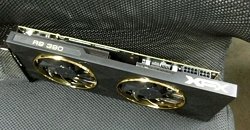Thursday, April 9th 2015

Is This The XFX Radeon R9 390 Double Dissipation?
Some of the first pictures of XFX' Radeon R9 390 Double Dissipation graphics card made it to the web, weeks ahead of its launch. The card features a tall dual-slot cooling solution, featuring two 100 mm spinners, ventilating a large aluminium fin-stack heatsink. The card draws power from a combination of 6-pin and 8-pin PCIe power connectors. It features bridge-less XDMA CrossFire, much like the R9 290 series.
The second-best SKU carved out of the "Bermuda" silicon, the R9 390 will be positioned a notch below the R9 390X. There's no word on its specs, or how AMD carved it out of the "Bermuda" silicon, which features 4,096 stream processors based on the latest version of the Graphics CoreNext architecture, and a 4096-bit HBM memory interface, churning out 640 GB/s of memory bandwidth. AMD could allow its partners to come up with custom-design cards from day-one, with memory amounts ranging between 4 GB and 8 GB. The R9 390X and the R9 390 will be competitive with NVIDIA's GeForce GTX TITAN X, and other upcoming cards based on the GM200 silicon, such as the GTX 990.Update 09/04: Some readers believe this card could be an R9 380, looking at the layout of components on the PCB from the top. We find this observation equally plausible. The R9 380 is essentially a rebadged R9 290 series, which AMD could sell at price-points competitive to the GTX 970.
Source:
WCCFTech
The second-best SKU carved out of the "Bermuda" silicon, the R9 390 will be positioned a notch below the R9 390X. There's no word on its specs, or how AMD carved it out of the "Bermuda" silicon, which features 4,096 stream processors based on the latest version of the Graphics CoreNext architecture, and a 4096-bit HBM memory interface, churning out 640 GB/s of memory bandwidth. AMD could allow its partners to come up with custom-design cards from day-one, with memory amounts ranging between 4 GB and 8 GB. The R9 390X and the R9 390 will be competitive with NVIDIA's GeForce GTX TITAN X, and other upcoming cards based on the GM200 silicon, such as the GTX 990.Update 09/04: Some readers believe this card could be an R9 380, looking at the layout of components on the PCB from the top. We find this observation equally plausible. The R9 380 is essentially a rebadged R9 290 series, which AMD could sell at price-points competitive to the GTX 970.


53 Comments on Is This The XFX Radeon R9 390 Double Dissipation?
And yes they use the copper type.
Looks like they may of changed that heatsink, i would have to check as it's been a while since i looked at mine. Maybe in the next day i will has i need to swap out a motherboard anyways.
Full tower cases just take up too much space for me.
Sure, when I pump up the fan speed there is a lot of noise, but that doesn't bother me since I wear headphones with noise cancellation and maximum volume.
Reference cooling max's out under 40C under heavy load ever since my 2900XTX days up until my 290X.
Looking forward to the 390/x's, especially the reference cooling ones.
I always read about people complaining about the reference cooling, maybe I just always end up with a 'Super-fan', maybe people are not adjusting fan speeds, maybe people care too much about noise. I have always thought that with great power comes great noise :)
In-fact, the only reference coolers I ever had trouble with was the Nvidia range. I remember I had to modify my cooler on the 8800GTX, but that was a fun project :)
For example one power phase designed with regular mosfets can output 70 amps while dissipating 60W as heat ... the same phase using integrated power stage can output 60 amps while dissipating only 11 watts as heat. That's why when you see VRM array with integrated circuits it's often with less phases for the same power capability and much less heat.
Also, it's not that rare for design to have many phases just to make each phase less hot, rather than to allow extra oc.
Best built/looking gfx card ever. (IMO)
R5/7/9 are used, there is space for R6/8/10 ^^
You should recognize the second one.
This just looks like a XFX 290/X with a different shroud really.
If the photos showing the R9-380 has a lower TDP draw in comparison to it's R9-290/290x cousin, it's possible and reasonable to believe in these images, the R9-380 is design this way because the card itself won't generate higher or equal temperatures on loads.
I believe that AMD has a predictable trend with each generation. AMD 7970 had Frame Time Variance Issues in CrossfireX. Frames were dropping and runt-frames manifested itself. This was more noticeable in the AMD 7990 Graphic Cards. R9-280 was released correcting these issues in the preceding generation. Frame Time Variance Curves displayed that R9-280 was less spikey, curves didn't hit zero, but they weren't ideal curves like NVidia Frame Time Variance Curves. Nevertheless, they were improvements.
R9-290x has GPU Core Frequency throttling issues. This is either due to an increase in temperatures on the GPU or VRam. So naturally, R9-380 (a revision of the R9-290x) is going to have temperature and power draw improvements. Power Draw is actually smaller in comparison to the R9-290x. So the nuclear reactor that we know as an R9-290x, is less radioactive in the R9-380. With this thought in mind, one can conclude that a massive air-cooled setup isn't necessary.
R9-380 doesn't have HBM which is one of many selling point for the R9-390 and R9-390x. Justification for the AMD Premium price tag that you'll see on the R9-390/x. R9-380 will most likely support D3D12.0. I don't believe R9-290x fully supports it, but I could be wrong.
Lets take into account that photos from Rumor Mills have shown R9-390x having a TDP Power Draw near R9-290x, but how accurate is that remains to be unclear. Those numbers won't be confirmed or verified until 3rd party benchmarks and test are made by TPU, etc... I would reasonably and generously suggest that R9-380 would probably have a 10% to 20% power draw less than R9-290x. Consider this an educational guess. In addition, it will probably produce 20% to 30% less generated thermal energy at the same amount of work outputs or loads with the air-cooled solution, on the R9-380.
The "actual" may produce better results than the things I have listed, exceeding the bar of expectations on the R9-380 higher than previously believed. If we think about it, AMD doesn't really need to produce another R9-290x variant and call it a R9-380, place more units on the market with no tweaks or improvements. Otherwise, the already flooded market of R9-290x will only increase with the volume of R9-380 products coming in. The only assumed difference between the R9-290x and the R9-380 would be the labeling in this case. My point is with the current situation, R9-380 "could" meet a higher level of expectations. In a sense, the R9-380 has to exceed the R9-290x, or AMD will just be increasing and investing stock to a flagship tier, one generation ago that consumers aren't buying anymore. Especially with the NVidia GTX 980 pulling a significant performance over it, and the previous generation, the GTX 780 Ti, was already pulling 10% to 22% average FPS over it in the same tier and generation as the R9-290x. I don't believe R9-380 is going to be sold for $100 to $200 dollars just to make up for losses... Especially if the average price of an R9-290x is roughly between $300 and $700 dollars.
the case can be vertically tiny or even a steambox (with pci-e riser to rotate the card) & fit extremely long cards just fine
Interesting thought as to R6/8/10 but that makes for an extremely crowded field
Trying to squeeze all that cooling performance out of dual slot design makes sense if you're going to run Crossfire but not so much otherwise.
"So what's the deal, little fella?"
"Well that's classified."
"So I couldn't tell you, even if I wanted to."
"But it is pretty cool."
"So I might tell you."
"
I'm gonna tell you."(For what it's worth, I see what you didthere...love ya for it....you're a clever
bastarddude.)I took some old PSU or CPU fans and spliced them on. Cut them out of their frames first, of course. Used gorilla glue to attach to original mounting bracket after I cut the middle spindle out. They spin slower but sit taller and its surprising how much better they cool. My 2nd card is a solid 10-20 deg C cooler. So these GPUs can run much cooler, its just the fans which suck.
But that won't stop AMD from lying about the clock speeds and using the boost clock as the advertised clock speed.
I'll be getting 3 40 inch monitors for Eyefinity.